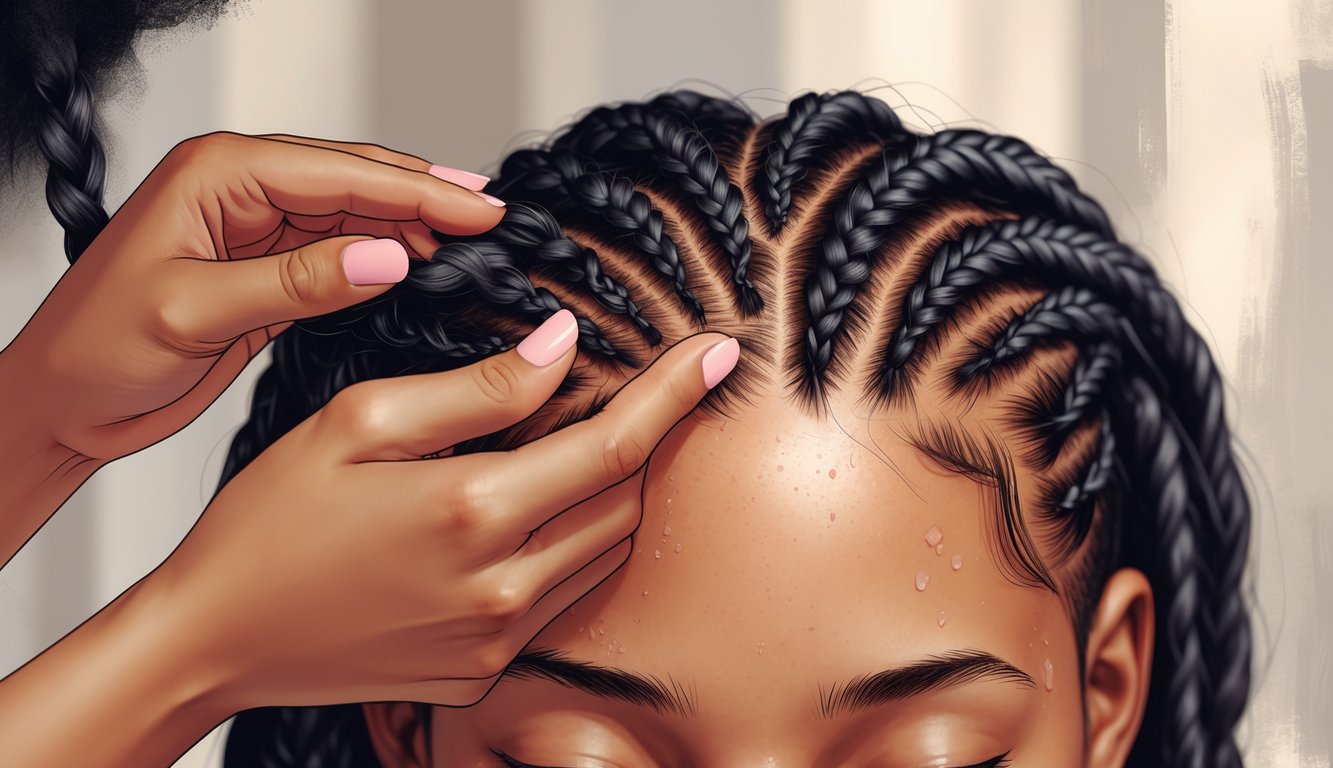
Alright, so here’s what’s wild: nobody actually talks about those weird, pulsing scalp bumps you get from tight box braids. Except, okay, my stylist did, but she kind of muttered it like it was a secret. “Too tight? You’ll regret it.” She was poking at my edges, probably making them worse, honestly. Every time I sit for braids, there’s this split second where I’m like, “Is this just secure or am I about to lose my hairline for good?” Stylists see actual scalp disasters all the time—irritation, bumps, and that dreaded traction alopecia—because braids that “feel secure” are basically follicle torture devices. Dermatologists (they’re always so serious) keep warning that tight braids yank at your roots, causing inflammation you definitely didn’t sign up for. Meanwhile, Instagram just shows those crisp parts and not a single flake in sight.
So then you’re stuck waiting, right? Will the style hold up, or will the soreness outlast the “fresh” look? Two stylists straight-up told me: sure, box braids seem healthy, but constant tension, especially near your temples or the back of your neck, is a silent killer. I used to think scalp massages were just extra, but apparently, they actually help your follicles chill out. The pros swear by lighter-weight hair and knotless braids for less pain. (Do they really though? I’m still skeptical.)
But then, boom, headaches, bumps, and regret. Braids can wreck your scalp without a single warning if you’re not paying attention. And honestly, who’s measuring “tension”? Should I bring a tension meter to the salon? Feels like nobody talks about this stuff, but if your braids are tight forever, you’re risking more than just a headache. Sometimes it’s a full-on hair crisis brewing under those neat rows.
What Are Box Braids and Why Are They Popular?
So, box braids. People act like they’re some new TikTok thing, but they’ve been around forever. Subway ads, your cousin’s prom photos, random mall kiosks—everywhere. Here’s what nobody says: not every braid is the same, not every “protective” style actually protects, and every single stylist I know has horror stories about people skipping prep. That pile of fake hair on your floor? Not a get-out-of-haircare-free card.
Overview of Box Braids
The “box” part is just the shape at your scalp—little squares. Then there’s the endless packs of synthetic hair, stacked up from root to tip until your neck forgets how to function. Box braids are ancient, like “South African tribes 3,500 years ago” ancient, and now you can get them knee-length or micro while bingeing reality TV.
I watched someone sit for seven hours—seven!—for mid-back knotless braids and then act like shampoo was a government conspiracy. (Please don’t do that.) Some people swear by mousse for frizz, but the real pros like Dr. Kari Williams say you need to actually care for your scalp or you’ll be scratching flakes for weeks. And the parting? If you’ve got sensitive edges, ask for bigger sections or you’ll regret it. If you want a deep dive, this background is weirdly fascinating.
Differences Between Box Braids and Other Braided Hairstyles
No, a French braid is not the same thing. (Why do people keep asking?) Box braids use extensions—kanekalon, whatever’s on sale. That’s why they last forever, like four to eight weeks, unless your scalp taps out first. Cornrows? They’re flat. Box braids? They stick out. It’s like comparing running shoes to stilettos: both cover your feet, but come on.
People mix up goddess braids and box braids constantly, as if “braids” is one big bucket. Even knotless box braids (which start with your own hair) are a thing now—less tension, supposedly. If you want to see all the types—bob, jumbo, micro—I send people to this guide. It’s easier than trying to explain it at brunch.
Box Braids as a Protective Style
“Protective style” sounds like it should be foolproof, right? But the second you ignore your scalp, you’re basically asking for breakage and surprise damage. Braids are supposed to be low-maintenance—bun, ponytail, spritz, done. But people push wear time way too long because “it still looks fine,” and then, oops, matting and shedding.
Someone told me she had fewer split ends after box braids, but she “forgot” to wash her hair for weeks and then wondered why her scalp was on fire. Different hair reacts differently: fine hair snaps, coarse hair survives, but tension and weight are always lurking. If you want these things to actually protect your hair, you need a good install, clean parts, and actual moisture. I sneak leave-in conditioner under my braids now. Game changer? Maybe. At least my scalp isn’t plotting revenge.
Understanding Tight Box Braids: The Braiding Process
I’ve lost count of how many people I’ve seen wincing in salon chairs, trying to act tough so their braids look “snatched.” You can’t see tightness in photos, but your scalp? Oh, it knows. Pain, bumps, and random flakes show up hours later. Stylists go fast, and sometimes they pull so hard you want to scream. Extensions—human, synthetic, whatever—change the whole game.
How Tightness Is Achieved During Installation
Who decided “tighter is better”? Because at some point, numb fingers and burning edges just aren’t worth it. Stylists grip hair right at the scalp and yank each section tight. At first, it’s easy to ignore—everyone’s obsessed with crisp partings.
My friend’s stylist said, “It has to be tight to last.” Three days later, she had red bumps all along her hairline. Turns out, squishing hair at the root (especially edges or nape) basically guarantees inflammation—those “braid bumps” are real, and everyone’s talking about them. Stylists almost never check for circulation or skin color changes. If your scalp’s pink before you leave? Too tight. But people still tip. Why do we do this?
Braiding Techniques That Impact Tension
There’s this whole debate—are knotless braids really less painful? Some stylists swear by big sections, others do tiny squares and rush. Microbraids, feed-in, Ghana braids (YouTubers love those)—they all have their own ways to crank up pressure. My cousin’s braider “wraps” synthetic hair at the root and calls it a technique.
But too much stress, especially with Ghana or box braids, means you might end up with scalp irritation or even lose your hairline—traction alopecia is not a joke. Forget the headache; you’re losing actual hair follicles, sometimes with scabs or broken hair at the part.
I watched a stylist re-part someone’s hair three times, muttering about “laying the base.” Still did the first braids so tight I thought the client would cry. Nobody really explains how breakage happens if your scalp already hurts before you even leave.
Role of Hair Extensions in Box Braids
Synthetic hair (kanekalon, toyokalon, whatever’s cheapest) and human hair grip differently. Extensions add weight, which means even more tension—especially if you want long, dramatic braids like everyone on Instagram. Some stylists twist the extension right at the root, pinching your scalp so it won’t budge.
I tried feathered, pre-stretched packs once, thinking they’d be gentle. My scalp was raw for days. Extensions can make everything worse if your hair is dry, colored, or already fragile—they just pull harder at weak spots.
Dr. Crystal Aguh (dermatologist, very official) says heavy extensions are a major cause of traction alopecia and breakage. But nobody mentions this when they’re selling you extra hair. Human hair tangles less, but if the braid’s too tight? Doesn’t matter. Sometimes a braid unravels halfway down and the extension falls out, but the real damage is already done. Fun.



